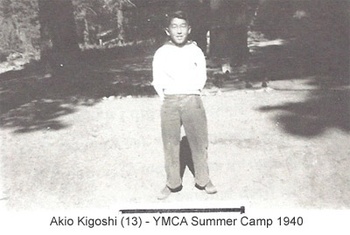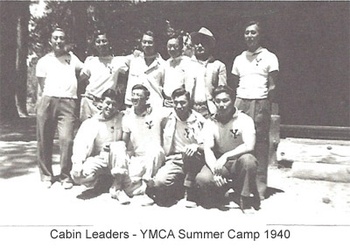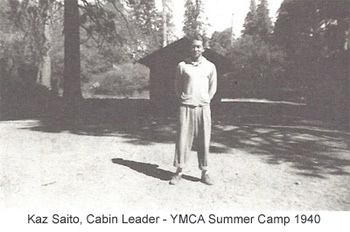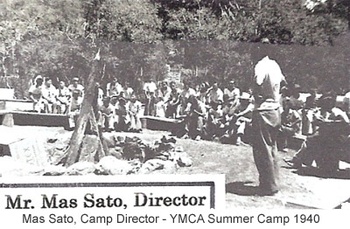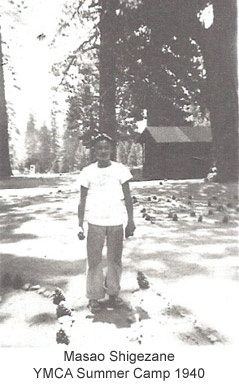My name is Akio Kigoshi. I was born in Kobe, Japan, on October 19, 1927, as the first son of Susumu and Toku Kigoshi. I turned out to be their only child. After I entered kindergarten in Kobe, my father was transferred, in 1933, to the New York Branch of the Japanese Steamship Company he belonged to, and my parents and I lived there until 1937, at which time we moved to Los Angeles. After finishing 5th and 6th grade at 36th Street Elementary School in L.A., I moved on to Mt. Vernon Jr. High School. And in September of 1941, just three months before World War II started, my parents took me back to Japan.
The older you get, the fonder your life of the past becomes. I reached 80 in October of last year, and just a few days ago, I found an article in the February 7 edition of Rafu Shimpo, with a photo that caught my eye.
The photo was of a boy I remember in my childhood days. I naturally felt the urge to get in touch with him, and immediately, with high hopes, sent an e-mail to the writer of the article. Shortly after, I was saddened to learn that my old buddy, Masao Shigezane, was killed in action serving the 100th/442nd Regimental Combat Team in World War II.
It was in the summer of 1940, when I was 13 years old, that I attended a YMCA summer camp for boys, sponsored by, I think, the Japan America Society of Los Angeles. It was a group composed of about 60 boys, ranging between 10 to 16 in age. The atmosphere was very friendly, and we all got along very well with each other. The camp was situated in a rural area at the foremost northeastern tip of L.A. County called Little Green Valley. I had never resided away from my parents until then, and even though it was only for two weeks, it seemed a lifetime to me. I was an only child, and my parents, too, no doubt felt the same, because they came by car at the middle of the two-week period just to see how I was getting along! Though I did get a slight sense of homesickness, it was an experience I shall never forget.
Masao Shigezane was one of my fellow members in the cabin that I was in. They were simple wooden shacks, with about six kids bunked in each cabin. I think it was the Japanese heritage of the Japanese American boys that made them behave the way they did. They were well disciplined. I never thought I would feel so relaxed amongst boys I never knew before.
Our cabin leader was Mr. Kaz Saito, a Pastor of the United Lutheran Church in Little Tokyo. After coming to Irvine to reside in 1989, I visited him, and we met after a hiatus of 49 years. Mr. Saito and his wife, Mary, came to visit us at our home in Irvine, in March of 1999. It was a devastating shock to me to learn that Mr. Saito passed away in February of 2006.
The other fellow cabin members were Ray Tadakuma, Bob Suzuki, Mako Oi, Theodore Arai, and Jack Kashihara, while Mr. Art Kaihatsu and Mr. James Yamanaka were other cabin leaders, and Mr. Mas Sato, was the Director of the camp. These names are very dear to me, and bring back fond memories of my two-week stay that will always remain close to my heart.
Since I'm taking a trip back to my childhood, I'd like to share some more memories. When my parents took me to New York from Japan in 1933, I had a close pal named Barry Grogan, who lived in the same apartment house that we did in Mt. Vernon, New York, and went to the same Lincoln Elementary School as I did. Years later, when I was living in San Salvador, Central America in 1970, I visited Barry in New York, and we had our first reunion in 33 years. Later, in 1977, during my 9-year stay in Leeds, England, I visited him again, and had our second reunion. Barry now lives in Florida, and we are still corresponding with each other. A 75-year relationship!
When I came to Los Angeles from New York in 1937, we first lived on La Salle Avenue, then moved to West 29th Street, both of which are near the corner of Western Avenue and Jefferson Blvd., close to the University of Southern California. The house on La Salle was in the 36th Street Elementary School/Foshay Jr. High district, so I attended 36th Street School. 29th Street, on the other hand, was in the Mt. Vernon Jr. High district, so I went there, whereas my fellow students went on to Foshay, as did Mas Shigezane. 36th Street School was full of Japanese Americans, while Mt. Vernon Jr. High was mainly Caucasian, and there were very few Nisei’s and Sansei’s. I was accepted in both neighborhoods and in both schools, and never felt any racial discrimination whatsoever. I do not think there were any racial tensions at all for adults either, that is, until the occurrence of “Pearl Harbor”.
I had a close friend in Mt. Vernon Jr. High named Bill Stamper. His locker was situated right underneath mine in the gym class. One day, when I reached up for my locker, I clumsily dropped it on his face, and his middle upper tooth was chipped. Despite this incident, he did not get angry at me, and allowed me to continue being his friend. When I was in Japan right after World War II, Bill came to Japan with the Occupation Forces in 1945, and we had a pleasant reunion. We had other happy reunions when I came to live in Irvine in 1989. These reunions in L.A. were with two other pals ( both were Caucasian like Bill ) of our Mt. Vernon Junior High School days. The first meeting, with the four of us, was on September 17, 1994, the second one on March 6, 2004, and the third one on August 1, 2006, which Bill could not attend because he was stricken with prostate cancer. Bill, very sadly, passed away on November 5, 2006. I was devastated!
What I related above is a good example of how Japanese & Japanese Americans, and people of all other ethnic groups, were accepted in society here in the United States. It could be said, however, that things are changing in this world of ours, and, that what I experienced in my childhood, sadly enough, is now something of the past.
I wish to end this essay by expressing my deep gratitude to each and every person that I encountered during my early days here in the United States of America.
© 2008 Akio Kigoshi


